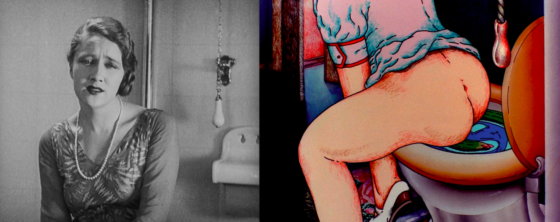Exploded View | Suzan Pitt

By Chuck Stephens
From Dragnet, “The Big Departure” (Jack Webb, 1968):
Kid, a would-be revolutionary just busted for stealing, among other things, asparagus seeds, with plans to cultivate them on the commune where he’s starting a new society: “Oh, yeah, I really dig fresh asparagus.”
Sgt. Joe Friday, arresting officer: “When do you think you’ll eat it?”
Kid: “This summer.”
Friday, with a curdled sneer: “Asparagus takes two years.”
Suzan Pitt’s Asparagus took four. A handcrafted surrealist masterpiece and in every sense a labour of l’amour fou, the extraordinary Asparagus—in a which a femme sans visage takes pleasure in her garden and shares the bounty of her unearthly delights with a mesmerized audience, all before performing fellatio on an alchemical assortment of possibilities—was animated and assembled between 1974 and 1978. Absolutely of its moment and ethereally out of time, it’s a movie designed to expand and contract: “The film is a circle more than a straight-ahead experience,” Pitt explained, “you could enter at any point and the meaning would be the same. The taking in and spewing out, the searching and the discovering, the desire and the contact, the ever-evolving acts of nature….”
By 1979, Asparagus had begun blowing minds twice on weekends in cities around the US, as the opening short before midnight screenings of Eraserhead (1977). That Pitt and Lynch were on similar frequencies was as plain to audiences then as it is painful to endure from pedigreed explicateurs today. So patent and potent are the felicities between their then-and-future films that they scarcely need renumeration: decaying Deco luxuriance, uncanny doubles, worlds within worlds, the beautiful ickiness of the corporeal, the terrible truth of dreams. They spring from the same seeds, these films, these filmmakers, both trained in the fine arts and their furthest possibilities. Most specifically, they were formed by the energies of Buñuel and Dali’s Un chien andalou (1929) and L’âge d’or (1930). It’s all there: mindboggling disjunctions and displaced blowjobs (Lya Lys and the stone toe); fecal daydreams (Lys enthroned) and obsessively deployed graphic patterns (checkerboard tiles, fecund florality, dizzying stripes.)
That Pitt is one of the most dazzling colourists in all of animation never fully disguises the existential discomfort and not infrequently blackened mirth on which aspects of her (and certainly Lynch’s) cinema depends. In Pitt’s Crocus (1971), a woman enjoys an erotic interlude with her comically super-endowed lover beneath striped sheets while an assortment of whimsical objects (including an enormous cucumber) are defenestrated overhead. Anyone who’s witnessed Gaston Modot’s frustration with the guernsey in his lover’s bed, and the giraffe and flaming Christmas tree he forces out the window in response, knows exactly where Pitt is coming from.
Pitt was born in Missouri, got a BFA in 1965, and by the end of the ’60s had begun making animated shorts in Manhattan. She developed a relationship with the Whitney Museum, and made a very cool animated commercial for their New American Filmmakers program in 1973; Asparagus was designed to debut as part of an installation there. She taught at Harvard’s Carpenter Center for the Visual Arts for several years in the ’90s, then at CalArts for another 20. Before she passed in 2019, she split her time between SoCal and Taos, New Mexico. As a child, she’d visited relatives in Mexico; there, and while travelling and painting in Guatemala, she’d formed large parts of the visual tapestry flowing forever within her.
Her films are miraculous. In Joy Street (1995), a Fleischer Studios-esque mouse saves a suicidal woman with displays of bathos and contortion that seem to reanimate Ub Iwerks with a heroic dose of empathy and psilocybin. El Doctor (2006) returns to Mexico for a parable about drunkenness, defeat, equestriana, and miracles. “Saint of Holes, Saint of Holes,” the film’s doomed resident mutters, growing old and approaching the end, “My asshole is a saint!” Her films have been restored by the Academy Film Archive, and remain in circulation both above- and underground. So much to discover in the bottomless Pitt!
Chuck Stephens

